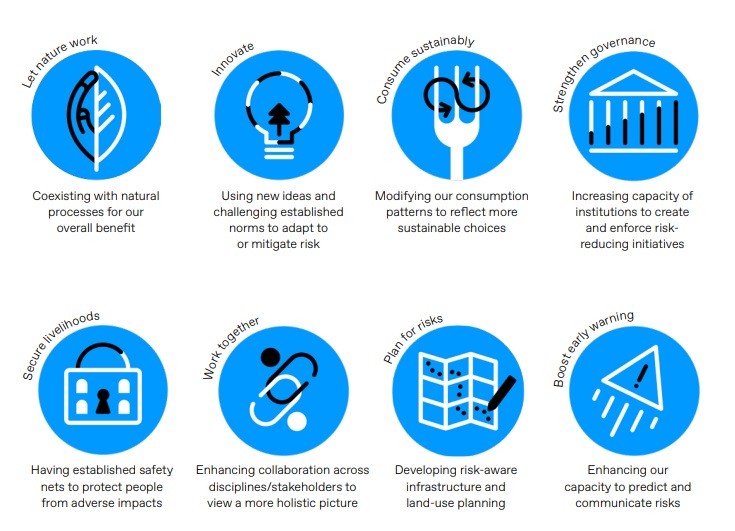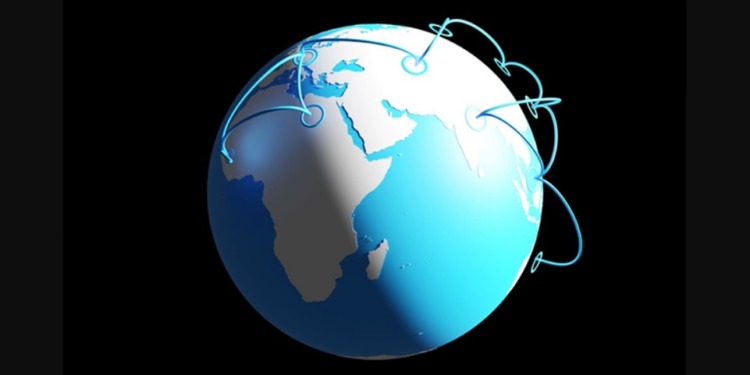Hazards like earthquakes, hurricanes, or volcano eruptions happen and they don’t need to cause disasters: The probability that they will occur and re-occur in particular geographic areas is usually well known, humanity should know better than being caught unprepared. Yet it happens over and over again – hazards turn into major disasters, lives are lost, and property is damaged. Last year was yet another record-setting year of catastrophic disasters, causing the loss of around 10,000 lives and over $280 billion in damage worldwide.
New United Nations research, the Interconnected Disaster Risks 2021/2022 report from the United Nations University Institute for Environment and Human Security (UNU-EHS), out yesterday, delves deep into the issue and comes up with real solutions.
Solutions that we would do well to heed if we want environmental hazards not to turn into disasters. Because the right solutions can reduce the risk of such hazards and prevent them from turning into full-blown catastrophes,- even, in some cases, eliminate them altogether. This is essential knowledge that needs to be operationalized: We need to realize that last year alone, from a record-breaking heatwave in British Columbia to wildfires in Greece, floods in Nigeria, and droughts in Taiwan, no corner of the world was spared. With climate breakdown accelerating, there’s no time left for procrastination.
Launched two months ahead of the annual UN Climate Conference, the report underpins that without urgent investments into the scale-up of solutions, the disasters we are currently seeing around the globe will be the new normal. It emphasizes both individual and collective responsibility to become part of the solution.
What the new Interconnected Disaster Risks Report Reveals
The report is solidly rooted in evidence: Ten major disasters that recently occurred were analyzed in depth. And, what is most important, this exercise provided a comprehensive understanding of the range of root causes of disasters, as they cover the whole gamut of possible disasters:
- Heatwaves (in British Columbia, there was “no plan for heat”);
- Earthquakes (Haiti caught unprepared even though it was “300 years in the making”);
- Hurricanes (Ida that “caught New York unprepared”);
- Floods (Lagos, Nigeria);
- Wildfires (in the Mediterranean, learning to “fight fire with fires”);
- Food insecurity (read: hunger, in southern Madagascar, “pushed to the limits of environmental extremes”);
- Drought (in Taiwan, when the “typhoons stop coming”);
- Volcano eruption (in Tonga, the “Big Bang that took the nation off the grid”);
- Species extinction (the case of the “vanishing Vaquita” off the coast of Mexico);
- Pressure on living space (the case of “wandering elephants”: No space left for those “wandering giants”).
All the drivers that cause disasters were systematically identified, from urbanization to deforestation. For example, as the report explains, deforestation leads to soil erosion, where a lack of trees and roots means that “there is no protection from wind and rain, and the soil is easily washed or blown away.” Once that happens, you have “the ideal conditions for multiple disasters, such as the devastating landslides during the Haiti earthquake, the formation of sandstorms in southern Madagascar and the sedimentation of water reservoirs in Taiwan.”
But it doesn’t stop there. Many disasters proved to be the result of several, interlinked causes created by our economic and/or political systems. The report provides many examples to prove the point, but here there is only space to mention one that is especially striking: Deforestation. As a driver, deforestation, as the report points out, “can be traced back to the tendency to pursue economic interests without regard for environmental externalities, a root cause defined as ‘Undervaluing environmental costs.’”
But the report does not focus on the negative aspects, it is also – and that is more important – positive, coming up with solutions: “The good news is that just as the disasters are interconnected, so are the solutions.”
Interconnected solutions for interconnected risks
The report’s authors are of course well aware that solutions are already being implemented around the world to address risks, but their point is that “interconnectivity is not yet placed at the heart of solution design and implementation.”
What is needed are “solution packages” that attempt to do this, bringing together the various strands – a “bunch” of measures – always keeping in mind the needs of the most vulnerable. The latter is both politically important and politically tricky.
The “most vulnerable” often do not have a voice to be heard or even a vote in the political system. As the report authors put it, “during the heatwave in British Columbia, people over the age of 50 were twice as likely to suffer from heat-related health issues as younger generations.” Or again, you have the example of the volcanic eruption in Tonga: It “left especially women without income as many of them depend on remittances from abroad, which could not be transmitted due to the interruption of the only undersea cable servicing Tonga.”
Not all solutions are the right one for everybody or, as the authors write, “convenient for everyone”.
To illustrate the point, the report asks us to consider how redistribution of resources can occur “among generations (Lagos flooding), countries (Haiti earthquake) and groups of people with different vulnerabilities (Hurricane Ida).” The latter case refers to the plight of poor people living illegally in New York City basements and who happened to be the worst hit by the flooding of lower areas.
Or the resources may have to be shared more broadly than they currently are if a solution includes addressing the problems of stakeholders who are rarely heard like the Vanishing vaquita – a fish, not a human.
Future generations will be impacted by environmental disasters that are “slow-burning” – especially those resulting from environmental degradation and climate change caused by human agency (read: economic pursuits). For example, as the report says, “children under the age of five are especially vulnerable to the long-term and lasting impacts of food insecurity affecting communities in southern Madagascar.”
Or consider the situation in “the very young nation of Nigeria, where almost half of the entire population is under 14 years of age, future generations will suffer from the consequences of today´s sand mining.”
So what are those “solutions packages”?
The report provides a simple and useful way to think of these issues and how to address them. The solution strategies are broken down into eight categories, as follows:

The report gives some telling examples of similar types of solutions working well across what would appear as totally different types of disasters:
-
- Enhancing early warning systems would have reduced the number of deaths during the British Columbia heatwave, the Tonga volcano’s tsunami and the flooding in Lagos;
- Consuming sustainably works in many circumstances: It can “reduce the strain on ecosystems we depend on for protection from hazards like the flooding seen in Lagos and New York”; it also helps to “preserve valuable food and water resources in times of scarcity”, as highlighted by the problem of species extinction (like the Vanishing vaquita) or the Taiwan drought;
- Technological innovations and preventive techniques are key for protection across a range of disasters: For example, using adaptive design, such as floating architecture, can help protect homes from flooding as seen in the Lagos floods;
- Harnessing nature to reduce hazards: For example, “prescribed burning to prevent mega-fires (Mediterranean wildfires), restoring forest ecosystems to stabilize the soil and prevent land degradation (Haiti earthquake, Taiwan drought, Southern Madagascar food insecurity), or regenerating urban streams and rivers and applying risk-aware urban planning to reduce flood risk (Hurricane Ida).
Solution packages that address one type of disaster can result in multiple benefits:
-
- Preventive techniques, such as beehive fences as were used in Kenya, proved to be highly effective and beneficial to farmers: They protected cropland from encroaching elephants “while at the same time providing honey and improving crop pollination”;
- Working together with local fisher communities to address the looming extinction of the vaquita resulted in co-management of conservation areas and that meant innovating and implementing more sustainable fishing methods, raising awareness for sustainable consumption and enforcing regulations to prevent harmful overfishing and illegal trade.
The point is this: Solution packages that attack the problem from different angles have a better chance of resolving the issue than if any of the solutions are implemented in isolation and without any dynamic interaction.
In this connection, the report authors note that “solutions cannot take place in a vacuum and have implementation barriers and trade-offs.” (bolding added)
By trade-offs, they refer to both environmental and societal trade-offs. For example, in the case of the British Columbia heatwave, there was a clear environmental trade-off: Giving increased access to air conditioning helps to reduce heat-related issues – unfortunately, conventional air conditioning also increases greenhouse gas emissions.
An example of a societal trade-off is given by “the case of the Wandering elephants, where the creation of habitat corridors or protected areas for Asian elephants would benefit the elephants but might result in a loss of land for people living in those areas.”
As the report concludes, “Only by thinking of the interconnectivity of our actions can these trade-offs be properly understood and sustainable solutions found.” And we need to consider the interconnectedness of disaster risks across time and space and work together to address different elements of disasters with a long-term perspective.
In short, the report identifies 8 solutions that can help to prevent or better manage the risks. They include:
- Let nature work (coexist with natural processes)
- Innovate (using new ideas)
- Work together (enhancing collaboration)
- Secure livelihoods (establish safety nets to protect people)
- Consume sustainably (modify our consumption patterns)
- Strengthen governance (increasing capacity of institutions)
- Plan for risks (being risk-aware in designing and building infrastructure)
- Boost early warning (enhancing our capacity to predict and communicate risks)
Delegates to the upcoming 27th United Nations Climate Change conference, known as COP27 to be held from 6 to 18 November 2022 in Sharm El Sheikh, Egypt, should take note.
Editor’s Note: The opinions expressed here by the authors are their own, not those of Impakter.com — In the Featured Photo: Our interconnected world, Source: United Nations University Institute for Environment and Human Security (UNU-EHS).









